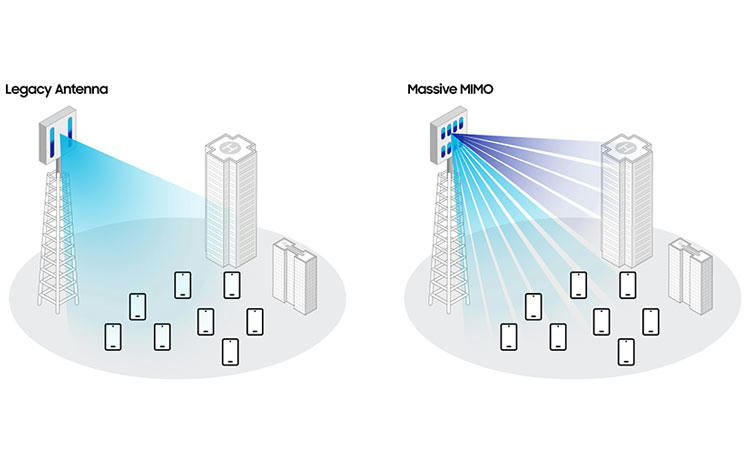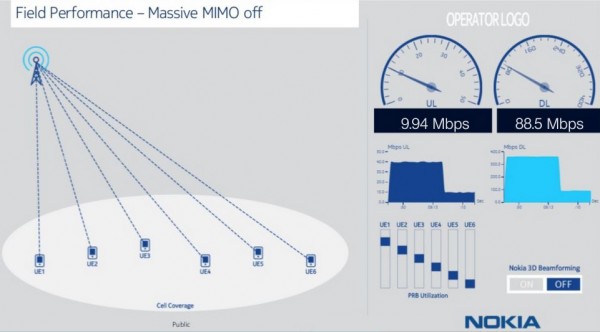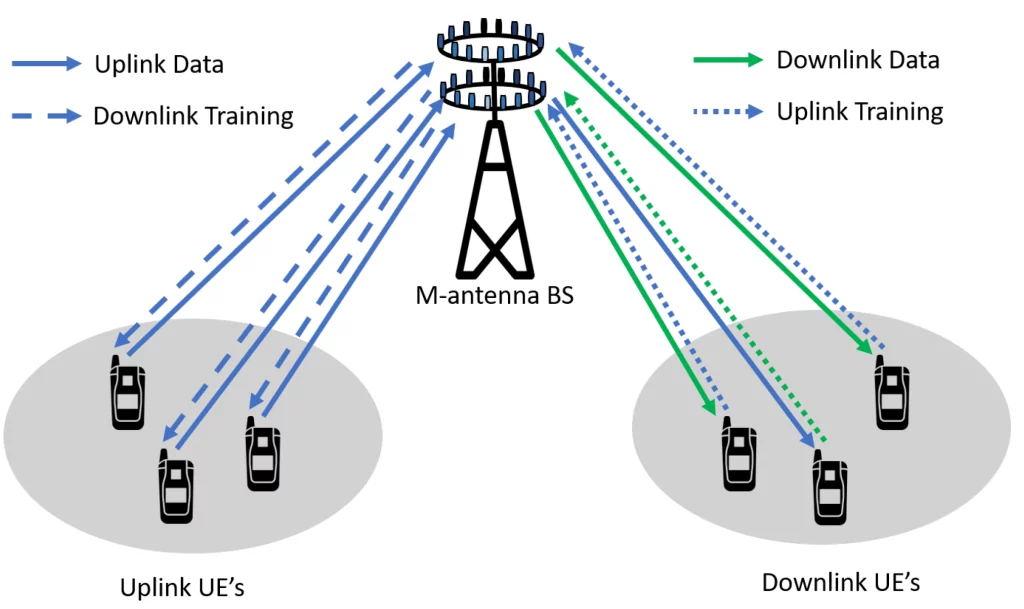In the realm of 5G networks, it’s no secret that massive MIMO technology reigns supreme. With its knack for increasing spectral efficiency, this tech has become a vital cog in the wheel of modern wireless communication. At its core, a massive MIMO system is comprised of an extensive array of antennas working in unison to transmit and receive data jointly. This multi-antenna approach is what allows such systems to provide superior coverage and higher data rates than their conventional counterparts.
To maximize spectral efficiency even further, one can up the ante by cranking up the transmit power on these already brawny systems. This added juice helps overcome pesky signal attenuation due to distance or other obstacles between sender and receiver. But beware – while more power does translate into better network performance, it also comes with energy consumption implications that shouldn’t be ignored nor underestimated.
Another area where researchers are putting their heads together involves enhancing uplink massive MIMO systems’ efficacy (where users send signals back from devices using multiple antennas simultaneously). By optimizing resource allocation (think bandwidth and transmit power) while minimizing user interference, scientists hope to achieve peak performance without sacrificing quality or reliability. One standout technique worth noting involves bumping up transmit power alongside uniform linear array gain all while keeping inter-user interference at bay through slick precoding techniques.

Increasing Spectral Efficiency in Massive MIMO Systems by Improving Transmit Power
Contents
- 1 Increasing Spectral Efficiency in Massive MIMO Systems by Improving Transmit Power
- 2 Uplink Massive MIMO Systems and Efficiency Augmentation
- 3 Enhancing Energy Efficiency in Massive MIMO Cellular Systems
- 4 Multi-Cell Massive MIMO Systems and Array Gain
- 5 Uplink and Downlink Transmission in Massive MIMO Networks
- 6 Analysis of Massive MIMO Channel Capacity and Interference Reduction Techniques
- 7 Future Outlook: Improving Spectral and Energy Efficiency in Wireless Communication Systems through Massive MIMO Technology
The sheer magnitude of MIMO technology for 5G networks is a wonder to behold. Its ability to increase spectral efficiency is truly impressive, but there’s more! By improving transmit power in this system, we can enhance this capability further and achieve phenomenal results. Transmit power holds the key to unlocking the best possible uplink and downlink transmissions within cellular networks.
But wait, how do we improve transmit power? We need to look at the antenna configuration used by our massive MIMO system. The uniform linear array (ULA) is one such setup that has been proven effective in providing significant gains in terms of both spectrum efficiency and ULA gain. This type of antenna array comprises multiple antennas placed along a straight line with high precision combining signals from different directions.
By optimizing ULAs and advanced antenna configurations, we can soar higher than ever before regarding spectral efficiency while minimizing interference between users on the same network. As 5G networks continue their evolution, it will be increasingly crucial for operators and equipment manufacturers alike to focus on developing new technologies that harness these capabilities while ensuring compatibility with existing systems – this is where future greatness lies!

Uplink Massive MIMO Systems and Efficiency Augmentation
Uplink Massive MIMO systems are an integral part of the 5G network, facilitating high-speed wireless communication with remarkable efficiency. However, interference is a persistent problem that hampers their performance and effectiveness. To counteract this issue, innovative techniques such as beamforming and power control can be employed to streamline the transmission process.
Augmenting efficiency in uplink Massive MIMO frameworks is crucial for enhancing energy proficiency while maintaining top-notch transmission quality. Amplifying transmit power may seem like a quick fix; yet it comes with its own set of obstacles, notably amplified levels of interference. Therefore, harnessing advanced algorithms to optimize transmit power based on channel conditions can significantly boost energy efficiency without compromising quality.
Multi-cell Massive MIMO systems represent another area where augmenting system efficiency plays an indispensable role in improving spectral efficacy while mitigating interference levels. By leveraging array gain techniques at base stations and coordinating transmissions between cells, these systems have shown tremendous potential in operating effectively even under highly congested circumstances thanks to advancements in antenna technology.
In essence, Uplink Massive MIMO Systems are critical components of wireless networks providing fast data transfer abilities coupled with enhanced energy proficiency compared to traditional methods. Efficiency boosting tactics like increasing transmit power or implementing multi-cell massive MIMO solutions help fine-tune overall system performance while minimizing interference levels resulting in elevated user experience satisfaction. As we continue exploring new technologies aimed at further improving spectral and energy efficiencies within massive MIMO technology’s domain-the scope for innovation remains boundless!
Enhancing Energy Efficiency in Massive MIMO Cellular Systems
Researchers have been delving into various techniques to amplify energy efficiency in massive MIMO cellular systems. One approach involves using a uniform linear array (ULA) with numerous antennas, which augments the signal-to-noise ratio and reduces interference, leading to heightened spectral effectiveness.
Another method is amping up transmit power in massive MIMO networks; this calls for prudent contemplation as it could result in substantial energy consumption and potentially damage overall energy efficiency. Thusly, researchers are scrutinizing ways of uniformly increasing transmit power across all antennas or employing a ULA approach for more efficient use of power.
At an international conference, one study put forth a novel technique dubbed “data traffic reuse” that aims at enhancing both spectral and energy efficiency concurrently in massive MIMO cellular networks. The strategy involves reusing data traffic from neighboring cells while mitigating inter-cell interference through coordinated beamforming techniques and resource allocation schemes. This led to significant enhancements in both spectral and energy efficiencies without necessitating additional resources or infrastructure upgrades.
In sum, augmenting energy efficiency in massive MIMO cellular systems demands innovative approaches like those mentioned above that tackle issues related to array gain, transmit power management, interference reduction techniques such as coordinated beamforming schemes and resource allocation strategies like data traffic reuse for superior utilization of available resources towards achieving higher levels of both spectral and energy efficiencies.
Multi-Cell Massive MIMO Systems and Array Gain
The marvels of multi-cell massive MIMO systems are simply astounding. With the use of antenna arrays, these systems can enhance spectral efficiency and channel capacity in wireless networks to a degree never before seen. By deploying multiple antennas at the base station, multi-cell massive MIMO enables simultaneous transmission and reception of signals from numerous users on both the uplink and downlink. The benefits are unmistakable: significant increases in data rates per user coupled with exceptional inter-cell interference management.
As technology for 5G networks continues to evolve, large-scale MIMO has become increasingly popular. These modernized systems integrate hundreds or thousands of antennas at the base station that enable beamforming techniques while enhancing spatial multiplexing capabilities for even greater spectral efficiency. Pilot reuse schemes have also been developed to reduce overhead signaling without sacrificing detection accuracy for uplink 5G massive MIMO cellular systems.
However, one perplexing challenge facing multi-cell massive MIMO is figuring out how best to manage inter-cell interference caused by overlapping frequency bands between neighboring cells. To address this issue head-on, researchers are exploring advanced signal processing techniques like coordinated beamforming and interference alignment algorithms that mitigate inter-cell interference while improving spectrum efficiency in a bursty fashion.
There’s no denying it; as these technologies continue to develop, we can only anticipate even greater improvements in network performance through multi-cell massive MIMO antenna systems bursting forth onto new horizons!
Uplink and Downlink Transmission in Massive MIMO Networks
The remarkable role of uplink and downlink transmission in the world of massive MIMO networks cannot be overstated. These systems have proven to be a game-changer for 5G wireless communication, elevating spectral and energy efficiency to new heights. With multiple antennas stationed at the base station for uplink 5G massive MIMO, signals from user devices can now be received simultaneously with unparalleled signal strength bolstered by mmWave frequencies.
It’s no wonder that energy-efficient massive MIMO systems are all the rage nowadays – they offer data transmission using fewer resources while still maintaining high spectral and energy efficiency standards. In fact, analysis has shown these systems effectively reduce interference between users leading to an overall network performance improvement.
As cell density continues to rise in urban areas, it becomes even more apparent how beneficial massive MIMO antenna technology can be. By employing numerous antennas within this system, higher array gain is achieved along with improved spatial resolution resulting in better channel estimation accuracy. Furthermore, intelligent algorithms can optimize beamforming techniques generating greater gains in spectral efficiency without compromising power consumption levels.
However, it’s important to note that perfect alignment between all antennas isn’t always feasible due to physical limitations such as size or environmental factors like reflections or blockages. Nevertheless, research shows that advanced signal processing methods including precoding and equalization techniques enable significant enhancements even with imperfectly aligned antennas within the massive MIMO system.\n
Analysis of Massive MIMO Channel Capacity and Interference Reduction Techniques
The Analysis of Massive MIMO Channel Capacity and Interference Reduction Techniques is a perplexing task but crucial for the seamless functioning of wireless communication systems. The mmWave frequencies hold the promise of unleashing a burst of data transmission with their large bandwidth, but at what cost? The challenges that come along, such as higher path loss and reduced coverage area, have left researchers scratching their heads in bewilderment. However, multiuser massive MIMO techniques utilizing beamforming can be implemented to focus on specific users or areas.
Improving detection algorithms is another way to boost efficiency in massive MIMO systems. Detector design plays an indispensable role in capacity enhancement and interference management for uplink 5G networks. Among other detectors, minimum mean square error (MMSE) detector has been proven to provide better performance due to its remarkable ability to suppress inter-user interference while maintaining high signal-to-noise ratio (SNR).
When designing cellular systems using Massive MIMO technology, energy efficiency should also be considered along with channel capacity analysis. To optimize area energy efficiency in massive MIMO cellular systems, power consumption must be minimized at base stations (BS). This can only be achieved by reducing the number of BS antennas while still fulfilling system requirements efficiently without compromising quality-of-service demands. In summary, analyzing various aspects like downlink and uplink transmissions alongside multiuser MIMO will help improve both spectral and energy efficiencies without leaving researchers feeling bewildered anymore!
Future Outlook: Improving Spectral and Energy Efficiency in Wireless Communication Systems through Massive MIMO Technology
The advancement of wireless technology has brought about an urgent need for enhanced spectral and energy efficiency. Fortunately, Massive MIMO technology is a beacon of hope in this regard as it offers the potential to increase network capacity without necessitating additional bandwidth. With recent improvements in MIMO infrastructure, smart cities can now be constructed with maximal spectral efficiency, resulting in gains not only in area energy but also overall system performance.
One approach that Massive MIMO systems utilize to enhance their spectral efficiency is by employing selection-based detection for uplink transmissions. By cherry-picking the strongest signals from multiple antennas, interference can be greatly reduced while augmenting the overall performance of the system. Moreover, distributed antenna systems further amplify both area energy and spectral efficiencies by strategically placing antennas within specific regions.
Another way to boost the efficacy of these distributed antenna systems is through proper power allocation across multiple antennas. This optimization helps bring about maximum coverage whilst minimizing wastage of valuable resources such as energy. As communication technologies continue to advance at a breakneck pace, there’s no denying that Massive MIMO will play a pivotal role in achieving greater levels of both spectral and energy efficiencies without compromising on reliability or performance whatsoever!


